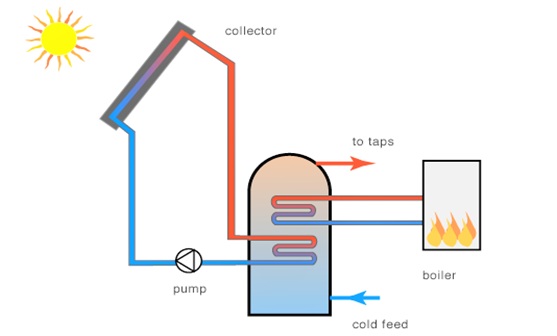What is a solar thermal collector?
A photovoltaic (PV) collector converts rays into electricity and offers many benefits, such as energy storage (see this page to learn more about the latest solar energy news).
The thermal sensor works much more simply. The heat from the rays accumulates and is retransmitted into the air or water, without conversion or expensive devices. The principle is exactly the same as that of your garden hose in summer: the rays heat the water contained in your hose without any additional intervention …
There are countless models of these thermal collectors on the market, to heat water or your home, but if you feel like tinkering, you will find everything you need on the Internet to make it yourself.
In all cases, in a cold climate, it is glycol that will flow in the sensor tubes to prevent the panel from freezing.
Is a thermal sensor effective?
The efficiency of a solar thermal collector is determined in part by its absorption rate, and in part by its emissivity. Its effectiveness is therefore not limited to the level of heat it will collect, but also to the rate it will emit (or loss) before it reaches its destination.
The first models had very high absorption rates, around 90 to 95%, but they also had emissivity rates of around 55 to 95% … The balance between the two was no longer so interesting: all the heat could be lost before reaching your destination! These models also used a standard black paint, while current models have coatings designed to absorb, and retain heat.
Even if the new generation of thermal collectors available on the market are really efficient, their “competitor” in the solar industry, photovoltaics, exceeds the old advance of thermal and affects the return on investment. Not that the quality and efficiency of solar thermal is declining, but there is a school that says that a solar dollar is better invested in photovoltaics, even using the energy generated to heat water with a water heater. traditional.
This lag is explained by the fact that, even if photovoltaic panels have been the subject of significant technological advances, their cost is constantly falling. For their part, thermal panels are displayed roughly always at the same price. And the thermal design is still very good, but the competition is improving a lot.
The comparative advantage of photovoltaics weighs heavily in the balance: while solar radiation must be used instantaneously with a thermal sensor, it can be used by many devices, be stored in batteries or sent to the public grid against a credit. Hard to be more
But there are situations where thermal solar is useful, so let’s take a look at the main collector models.
Vacuum tube heat collectors
This is the most common type. Usually composed of glass tubes containing copper pipes, covered by dark plates to absorb heat. The tubes, which are hermetically sealed, are installed separately in the manifold, making it easy to replace a tube if it is cracked or the seal is broken. The system is also easier to install since there is no need to transport a single heavy panel, but rather individual parts.
The airtight seal provides excellent insulation and makes the sensor virtually insensitive to outside temperatures in winter. Even in the summer heat, you could touch the tubes with your bare hands, while the heat of the copper pipes is unbearable.
Flat solar collectors
Designs vary slightly by brand, but basically, it’s a shallow box with copper coils running in it, covered with an absorbent metal plate and a transparent one.
The fresh liquid is pumped through the tubes and heated in the loop. A mixture of glycol circulates in the lower plate and the copper tubes; these two components therefore require specific storage tanks equipped with coils for the transfer of heat.
Flat, vacuum packed: which one to choose?
Each of the thermal sensors has advantages and disadvantages. Collectors with vacuum tubes provide better insulation than the flat closed panel model. Flat collectors lose more heat, but they also capture a lot more.
In the absence of other decision-making factors, we will choose our model according to the seasons: if you want to capture heat in summer, to heat a swimming pool for example, the flat collector is more appropriate. Conversely, to cover its needs in winter, we will opt for vacuum tubes, which lose less heat collected.
If you want to reduce heating costs on an annual basis, it is better to opt for a flat collector. If you want to use the solar system together with the water heater in winter, opt for vacuum pipes.
Heat transfer
Because of the glycol used in the system, a heat exchanger is required to transfer the calories that will be used to heat the house, water, or both.
The heated liquid from the solar panels transmits its calories to the water as it passes through a coil in the storage tank. An additional gas or electric powered coil in the tank will heat the water if the solar panel cannot maintain the desired temperature or sustain demand.
Maintenance and durability
In summer, a plate collector can reach temperatures up to 200 ° C (395 ° F), and tube collectors can reach temperatures up to 295 ° C (563 ° F).
At these temperatures, glycol can degrade and become acidic, leaving deposits and corroding system components. It is therefore important to integrate a cooling mode into the system (manual or automated, they will both be suitable). This need largely explains why heat collectors are increasingly rare in Canada.




